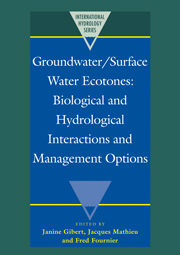Book contents
- Frontmatter
- Contents
- List of authors
- Preface
- I INTRODUCTION
- II FUNCTION OF GROUNDWATER / SURFACE WATER INTERFACES
- 2 Ecotonal animal assemblages; their interest for groundwater studies
- 3 Stochasticity in resource utilization by a larval chironomidae (diptera) community in the bed sediments of a gravel stream
- 4 Temporal and spatial dynamics of meiofaunal assemblages in the hyporheic interstitial of a gravel stream
- 5 Interstitial fauna along an epigean-hypogean gradient in a Rocky Mountain river
- 6 Filter effect of karstic spring ecotones on the population structure of the hypogean amphipod Niphargus virei
- 7 Community respiration in the hyporheic zone of a riffle-pool sequence
- 8 Diversity, connectivity and variability of littoral, surface water ecotones in three side arms of the Szigetköz region (Danube, Hungary)
- 9 Seasonal dynamics and storage of particulate organic matter within bed sediment of three streams with contrasted riparian vegetation and morphology
- 10 Bedsediments: Protein and POM content (RITRODAT-Lunz study area, Austria)
- 11 Dynamics and vertical distribution of particulate organic matter in river bed sediments (Morava River, Czech Republic)
- 12 Surface water/groundwater/forest alluvial ecosystems: functioning of interfaces. The case of the Rhine floodplain in Alsace (France)
- 13 Modelling of hydrological processes in a floodplain wetland
- 14 Contribution to the groundwater hydrology of the Amboseli ecosystem, Kenya
- 15 The role of hydrology in defining a groundwater ecosystem
- 16 Typology of water transport and chemical reactions in groundwater/lake ecotones
- 17 Development of a water transfer equation for a groundwater/surface water interface and use of it to forecast floods in the Yanghe Reservoir Basin
- 18 Uses and limitations of ground penetrating RADAR in two riparian systems
- III MALFUNCTION OF GROUNDWATER / SURFACE WATER INTERFACES: CAUSES AND METHODS OF EVALUATION
- IV MANAGEMENT AND RESTORATION OF GROUNDWATER / SURFACE WATER INTERFACES
- V CONCLUSION
- ANNEX
8 - Diversity, connectivity and variability of littoral, surface water ecotones in three side arms of the Szigetköz region (Danube, Hungary)
Published online by Cambridge University Press: 07 September 2010
- Frontmatter
- Contents
- List of authors
- Preface
- I INTRODUCTION
- II FUNCTION OF GROUNDWATER / SURFACE WATER INTERFACES
- 2 Ecotonal animal assemblages; their interest for groundwater studies
- 3 Stochasticity in resource utilization by a larval chironomidae (diptera) community in the bed sediments of a gravel stream
- 4 Temporal and spatial dynamics of meiofaunal assemblages in the hyporheic interstitial of a gravel stream
- 5 Interstitial fauna along an epigean-hypogean gradient in a Rocky Mountain river
- 6 Filter effect of karstic spring ecotones on the population structure of the hypogean amphipod Niphargus virei
- 7 Community respiration in the hyporheic zone of a riffle-pool sequence
- 8 Diversity, connectivity and variability of littoral, surface water ecotones in three side arms of the Szigetköz region (Danube, Hungary)
- 9 Seasonal dynamics and storage of particulate organic matter within bed sediment of three streams with contrasted riparian vegetation and morphology
- 10 Bedsediments: Protein and POM content (RITRODAT-Lunz study area, Austria)
- 11 Dynamics and vertical distribution of particulate organic matter in river bed sediments (Morava River, Czech Republic)
- 12 Surface water/groundwater/forest alluvial ecosystems: functioning of interfaces. The case of the Rhine floodplain in Alsace (France)
- 13 Modelling of hydrological processes in a floodplain wetland
- 14 Contribution to the groundwater hydrology of the Amboseli ecosystem, Kenya
- 15 The role of hydrology in defining a groundwater ecosystem
- 16 Typology of water transport and chemical reactions in groundwater/lake ecotones
- 17 Development of a water transfer equation for a groundwater/surface water interface and use of it to forecast floods in the Yanghe Reservoir Basin
- 18 Uses and limitations of ground penetrating RADAR in two riparian systems
- III MALFUNCTION OF GROUNDWATER / SURFACE WATER INTERFACES: CAUSES AND METHODS OF EVALUATION
- IV MANAGEMENT AND RESTORATION OF GROUNDWATER / SURFACE WATER INTERFACES
- V CONCLUSION
- ANNEX
Summary
ABSTRACT The 137 km long Szigetköz side-arm system extends on the right side of the river Danube in Hungary and shows the unique characteristics of river, shore, riparian forest, and groundwater ecotones. The investigated three side arms are in different alluvial stages, their surface sediment is variable: sand, sandy mud, mud, mud covered with detritus. The composition, life forms, and cover of aquatic macrophyte stands are good describers of the different side arms. On the surface of the sediment, the habitats are numerous and varied, and linked to the vegetation and open water region. Crustacean communities of these habitats are very diverse, mosaic-form, and are in dynamic connection with each other mainly through the developing stages, and even through certain stenoecious species.
INTRODUCTION
The Szigetköz Danube stretch in Hungary (1848–1806 river km) flows on its own alluvial cone. Fall is small, 3–10 cm km−1. A 137 km long side-arm system extends on the right side of the river, with 22.2 million m3 volume. The whole region is composed of five side-arm systems. Regulation activities began in the last century. The main goal of the engineering has been the assurance of the shipping on the Danube and the flood control. The present situation is the result of the regulation works carried out in 1966–1983 when numbers and heights of closing dams were increased. During low and mean water periods, 90 % of the water discharge flows in the Danube itself. Therefore, quantity and intensity of water supply of the side arms have decreased. The situation of the water table in the Szigetkoz region did not changed drastically in this period.
- Type
- Chapter
- Information
- Groundwater/Surface Water EcotonesBiological and Hydrological Interactions and Management Options, pp. 57 - 67Publisher: Cambridge University PressPrint publication year: 1997

